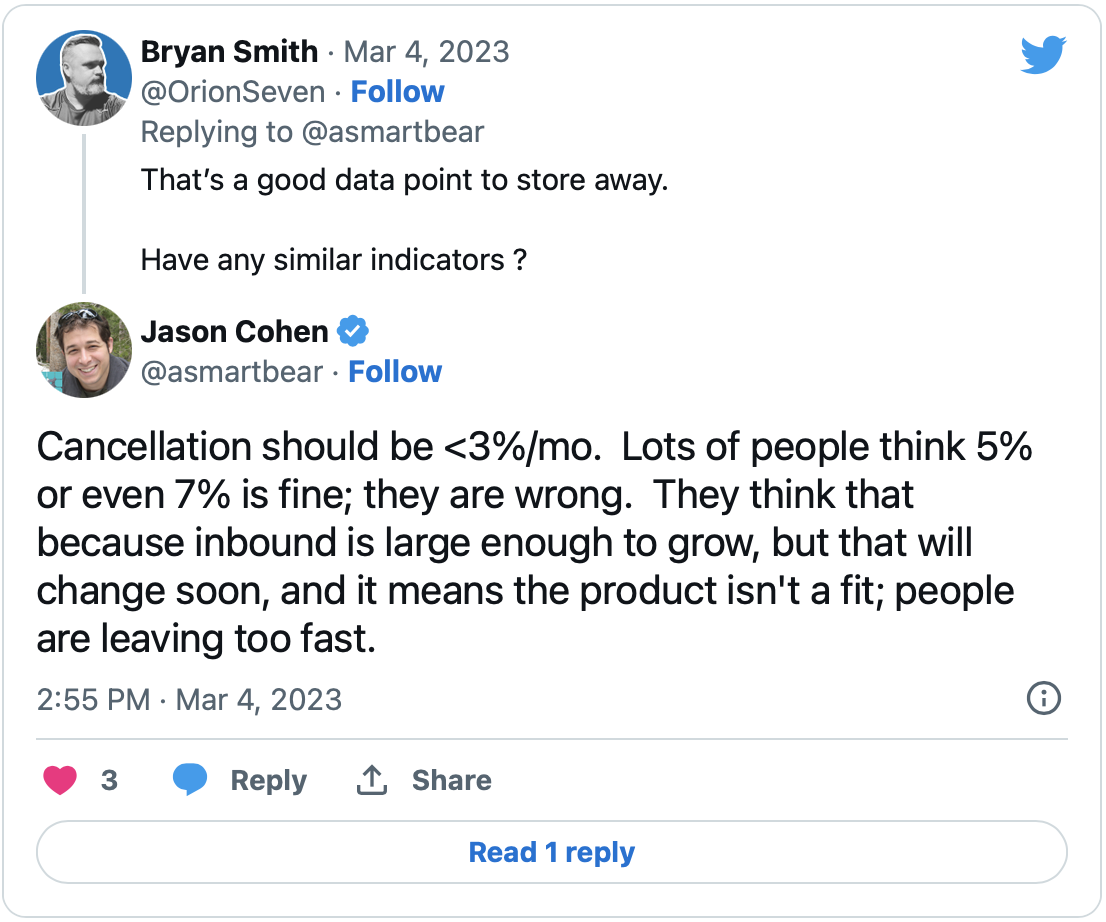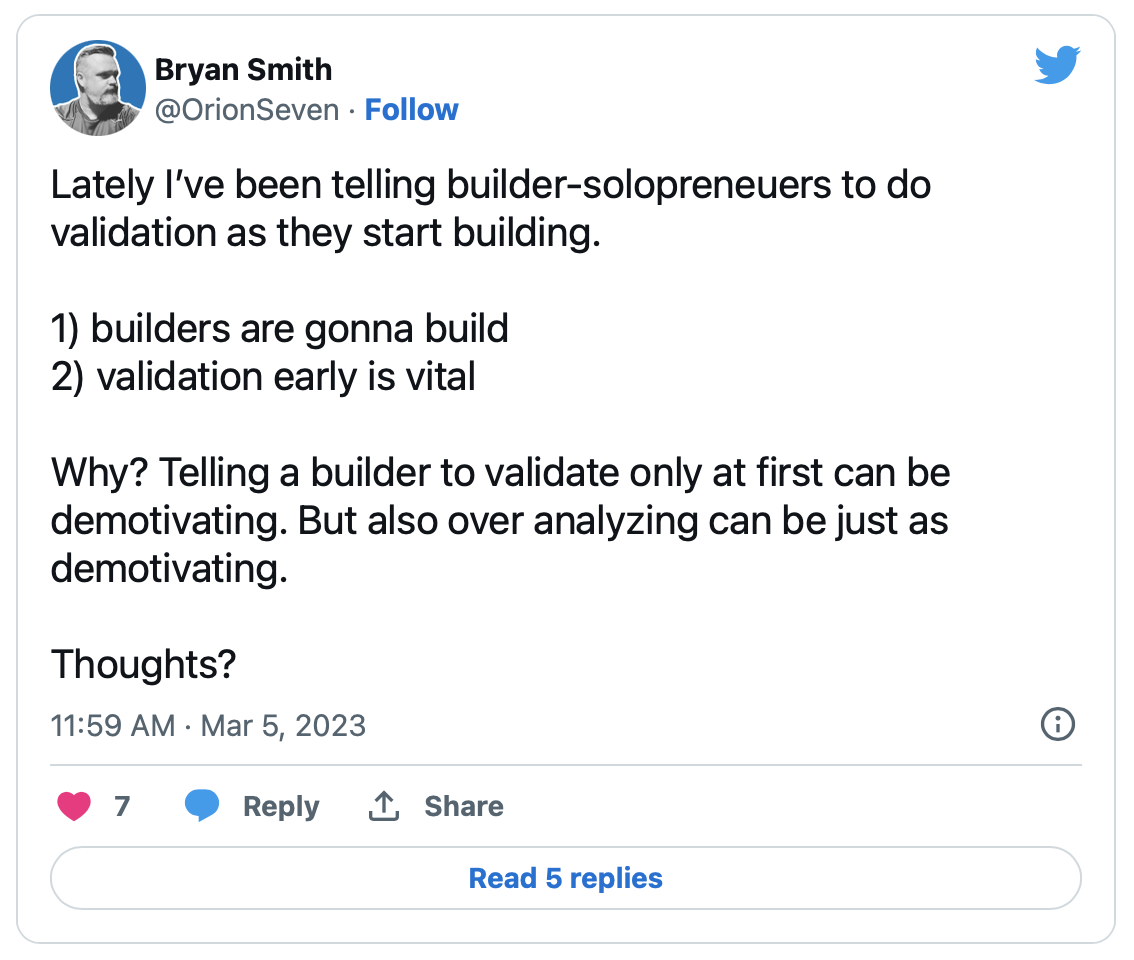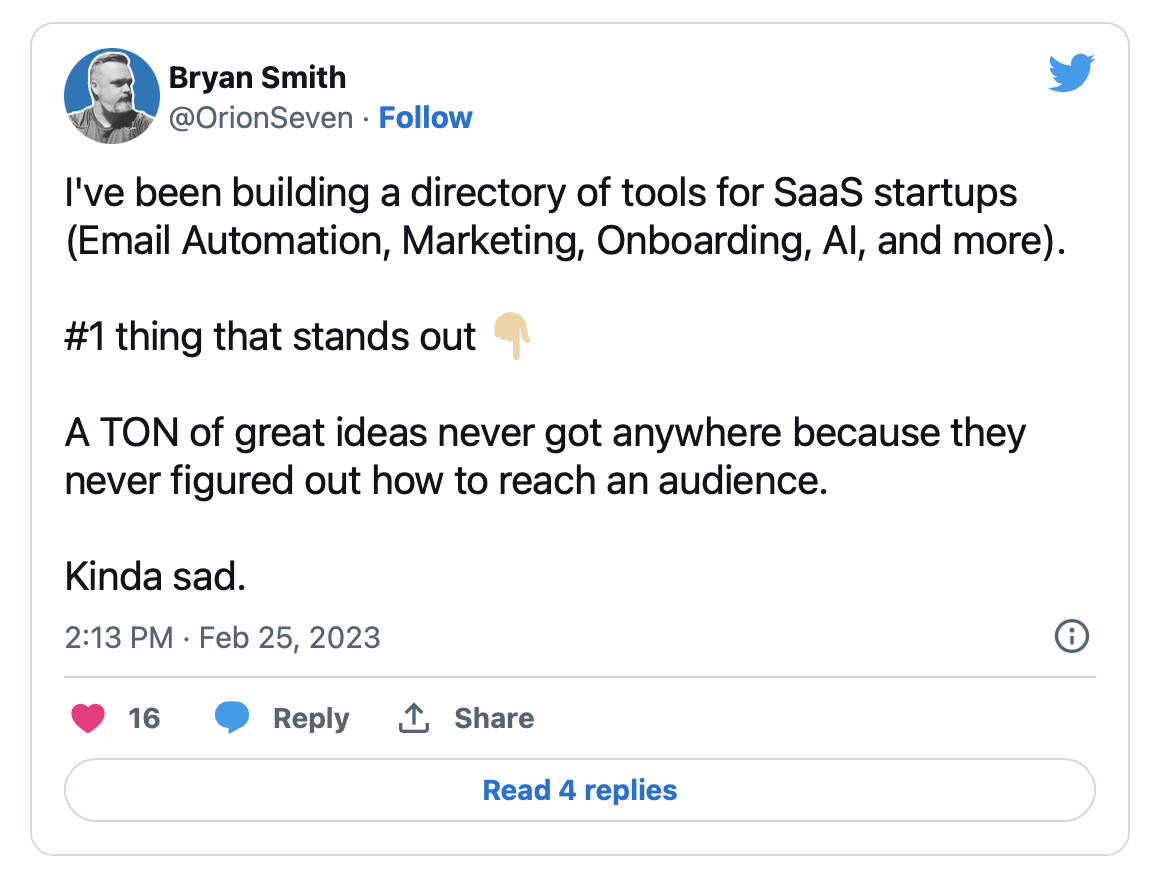Issue No. 9
Builders are gonna build
So you may as well make the most of it with this 3 part strategy to build and validate together.
Reading Time: 7 min

Source: DALLE, told to extract key phrases from this newsletter, create a prompt and using the style illustrative, colorful, futuristic create an image.
This week's issue is for you if:
- You've ever jumped head-first in and bought a domain, and started to code before talking to any prospects
- Don't know how to find your target market and begin validation
- Find that you tend to overbuild
But first…
This week's insight 👉 Churn 📉
Following this tweet, I asked Jason Cohen (of WPEngine) what other indicators a company is headed for hockey stick growth. His response is gold. 🥇 (so is his followup)

I've seen startups shrug off churn because they think their growth offsets it by a few percentage points.
Yikes.
Startups can't afford thin margins like this. If your bucket leaks fast (churn), do you want to say you have a great pump (new sales)?
No, you want to have as few leaks as possible AND a great pump.
Anyhow <3% / month, store that number away for later.
Builders are gonna build — So you may as well make the most of it

The above advice is my pragmatic response to everyone who wants to jump into code before validating their idea.
My response is simple — If you're going to build, then validate as well.
How'd I land on this advice?
Since I started ProductFoundry two months ago, I've noticed a recurring theme. Many great ideas started without knowing how to engage with their intended market.
So while my best advice is to validate first, my followup is to build and validate together.
BUT (you knew there was one coming) do it smart.
Here's how.
Step 1 — Start building a code spike (not an MVP)
First, what's a Minimum Viable Product (MVP)?
A minimum viable product (MVP) is a simplified version of a product that includes only its essential features and functionalities to satisfy early adopters and collect feedback for further development. (Definition by ChatGPT)
(Bold highlights are mine, you'll see why in a second)
And in the same context, what's the definition of a Code Spike in this context?
Just enough code to demonstrate the core feature/concept for your SaaS to collect feedback for validation.
Now let’s compare the bolded words.
MVP vs Code Spike
- "simplified version of a product" vs "just enough code"
- "essential features" vs "demonstrate the core feature/concept"
- "satisfy early adopters" vs "demonstrate"
- "collect feedback for further development" vs" collect feedback for validation"
Notice that for each statement, the code-spike has reduced it even further.
You could argue they're about the same.
And they are very close.
But I differentiate the two to hammer home the need for validation. Build no more than necessary to see if you're onto something.
This leads us to…
Step 2 — Optimize for Learning
You're building only enough to learn something. This is the classic Lean Startup, Build → Measure → Learn loop.
There's a lot of conflicting advice out there, but context matters. The advice below is for those just starting out with an idea.
🔸 The goal is to avoid pitfalls.
🔸 The goal is to reduce your time, money, and energy waste.
🔸 The goal is to optimize for learning
So, with this in mind, how do you validate your idea and learn what assumptions you got right and the many you got wrong?
Here's a straightforward list of activities I recommend.
1️⃣ Identify who you're building for — Brainstorm their job titles, interests, and the tools they use. Figure out Who. They. Are.
2️⃣ Identify the pain you're solving — Brainstorm the pain you're solving for your intended market. What problems do they face. What are the causes, and what are the symptoms. I think of this as "How were things BEFORE my solution."
3️⃣ Identify how you're solving it — Brainstorm how your solution fits the pains above. What are you doing that's different? "How will things be AFTER my solution."
4️⃣ Standup an email capture website — Now, using 2 and 3, create a hero statement. I like pain-focused ones. A 4-8 word sentence that describes or summarizes the pain. Make it a question.
Using 2 and 3 again, make 2-5 crisp sentences that help the reader identify themselves in the pain and that you're bringing them hope and they'll be the hero by using your solution.
Tip - ChatGPT is really great for helping here. Dump your brainstorming notes in and ask it to provide a summary, I like prompts that include "hook", "concise", and "crisp". It'll get the creative juices flowing fast.
5️⃣ Find your audience and engage with them — It's time to get out there and find your market. Figure out where they're hanging out. Everyone has a home on the internet. Go there and interact.
DO NOT PITCH. Participate.
Tip - Great places to look include: Reddit, LinkedIn, Twitter, Facebook Groups, Slack Groups, and Online Forums. DuckDuckGo (Google if you must) is your friend. Just start tossing different ways people identify themselves into search, and add Slack, Forum, and Community after your search term. There's also great tools for searching social.
6️⃣ Learn — As you engage with your target audience, you can't help but learn more about them.
- How do they talk? What's their lingo?
- What tools do they use?
- What are their norms?
- Are you seeing them talk about the problem you want to solve?
As you engage with them, again, do not pitch. Participate. You'll:
- Figure out how to talk to your market
- And build empathy for them ← This will pay dividends
7️⃣ Now, go back and keep iterating one through six.
You likely missed terms and names your market uses in your first pass.
You can use this to update your market definition → how you describe their pains → how you describe your solution → which lets you improve your email capture website.
After doing this for a couple rounds, it's time to...
Step 3 — Validate your idea
Many will say the only real validation is someone paying.
And I agree.
But, again, being pragmatic, most people are uncomfortable trying to get someone to prepay. So, I suggest focusing on indicators of validation.
What are good indicators? The two primary ones I go for are:
- Signups on your email capture website
- Feedback on your idea
Getting an email is easy, so you can't say one email == one purchase. It's only indicating interest. Expect a lot of people to signup just because their curious or just enjoying following someone's journey. But also expect a bunch interested in what you're making.
The last time I did this, I got over 400 people to sign up. That is a good indicator of validation.
Feedback on your idea is gold. Again someone taking the time to chat is not == a purchase. But again, they're showing enough interest in the problem you're trying to solve that they'll take a moment out of their busy schedule to talk and give feedback. Plus, that feedback is new learning!
At this point, you might be freaking out.
How on earth are you going to get anyone to find our website? How on earth are you going to find people to give you feedback?
This is why I say validate upfront. Doing so requires you to learn how to reach our market.

How do you get these indicators? Here are some practical and easy ways to start that are free.
🔸 Build in Public - Share what you're doing on Twitter and LinkedIn
🔸 Cold DM people asking for feedback. Make the request personal, don't spam
🔸 As you engage people (because you keep doing Step 2), when appropriate, mention what you're working on
🔸 Guest write articles where your market reads (websites, blogs, newsletters, forums). Again be careful with your pitch.
🔸 As people signup for your site, email them asking for feedback (email or zoom)
And if you have some money to spend
🔸 Create ads on LinkedIn, Google, Twitter, and Reddit. Drive them to your website.
🔸 If you've found newsletters for your target audience, buy an ad there
Step 4 - Repeat 1 through 3
As the saying goes, "the second verse is the same as the first!"
As you validate, you're assumptions and ideas will change what you desire to build.
That's precisely why you're doing it this way.
So keep building, refining your ideas, and building towards that MVP.
As people signup, keep them updated on the journey and share how the solution will work in little bites to keep the list warm.
As soon as you have something people can try, let them get their hands on it.
There are lots of tactics you can use here to increase validation (including pre-sales!). I'll save these for another newsletter.
Join the ProductFoundry Newsletter
Signup for insights into making great SaaS products and companies.